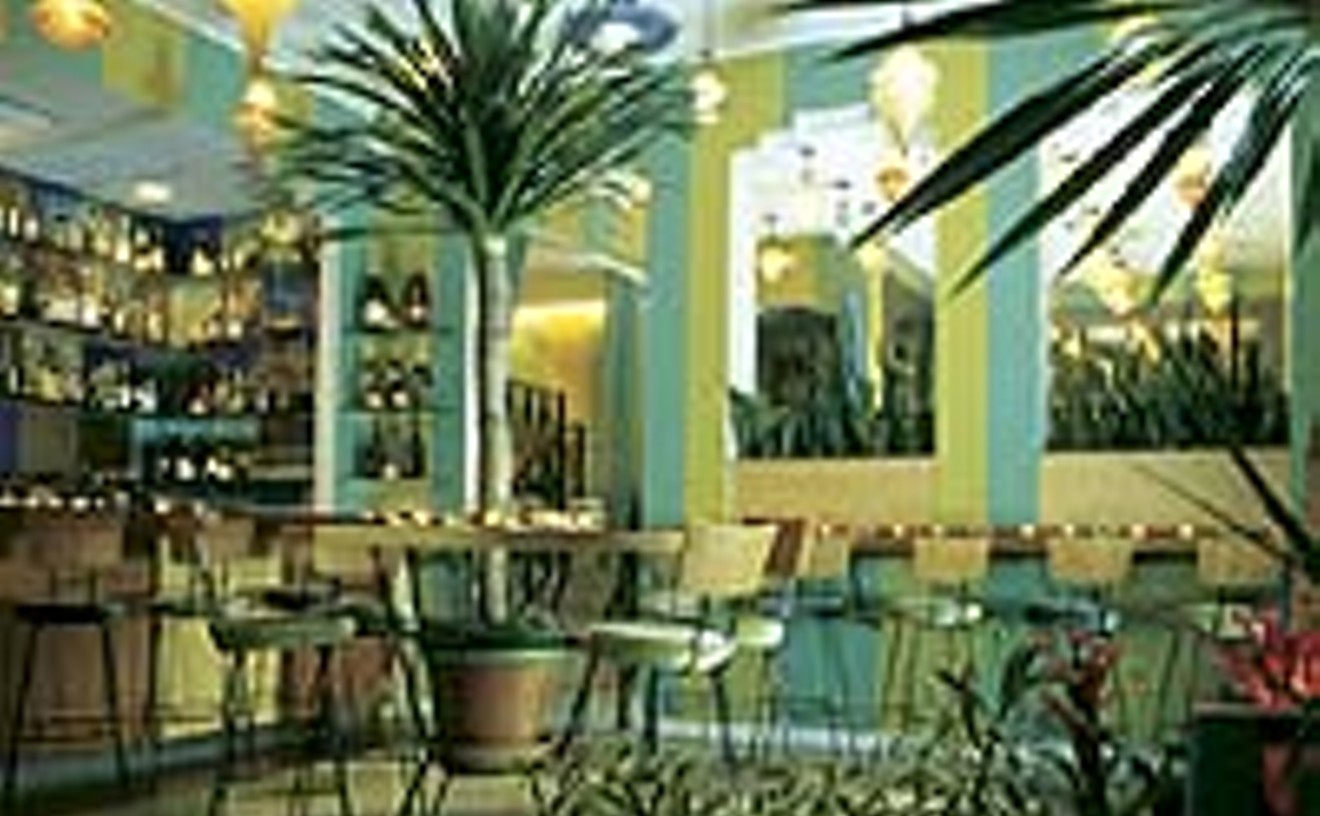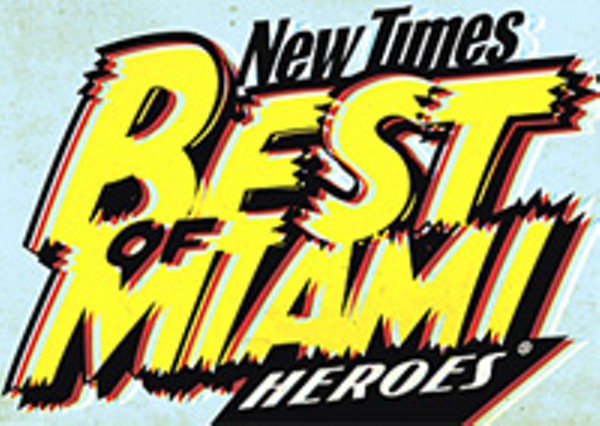Best Movie Theater
Regal Kendall Village Stadium 16
The scent of popcorn that embraces you as you enter this cinema might take you back to the old days of moviegoing, but there's nothing old-fashioned about the Regal Kendall Village Stadium 16. Opened in 2004, the theater has every amenity the modern movie watcher craves, from digital surround-sound to stadium-style reclining seats. Tickets can be purchased from the friendly cashiers or from the convenient computerized box office machines inside ($9.50 for adults, $6.50 for kids, $7.50 for a matinee). There's also a large customer service desk in case you want to buy a gift card without standing in the ticket line. The concession stand caters to the latest trends in cinema confections. You can get an iced coffee or a Cinnabon Gooey Cinnamon Roll, a giant pretzel or some El Monterey Southwest Chicken Taquitos. There are also traditional theater foods like nachos, and combos like a large popcorn, two drinks, and a kid's meal for $22.75. If you arrive a tad early for your movie, there are tables where you can sit and pass the time, or — for a little more action —you can visit the video game room, where a dollar buys you a role in The Fast and the Furious.
- 8595 SW 124th Ave., Miami, 33183 Map
- 844-462-7342
- regmovies.com/theatres/regal-kendall-village-imax-rpx/0996
Best Place to People-Watch
Government Center Metrorail Station , 5:00 p.m.
Metrorail is one of Miami's only mass transit systems, and despite its limitations, every day it transports thousands of people from all walks of life to their homes and jobs. Whether they're lawyers, sandwich-makers, college students, homeless vagabonds, or Brickell Avenue CEOs, they all share the burden of commuting in Miami. At 5:00 p.m., blue-collar, white-collar, and no-collar bodies leave their jobs or posts in the heart of Miami and make their way to the Government Center station. They squeeze into the train cars and try to grab a window seat before they're all taken. Most keep to themselves; a few are belligerent; some panhandle. A mother shushes her two young children. A dust-coated construction worker nods off. High school kids snicker. A twentysomething woman in business attire chats on the phone. Others wait for a seat to open up. A businessman gives up his seat for an elderly bag lady while a young skater nods his head to the blaring music coming from his headphones. Despite the miles and miles of suburbs, the Metrorail and its colorful passengers serve as a reminder that Miami is a big city. As the train reaches each stop, the crowd dwindles as people make their way off. On the Metrorail it doesn't matter where you're from or where you're going, just so long as you get there.
Best Film Festival
Women's International Film Festival
The Women's International Film Festival is an infant compared to the big boy FLIFF, but if this year's lineup was any indication, the new girl in town will be around for years to come. The scope and ambition of this festival is to be admired. This year's four-day extravaganza featured more than 40 films from twelve countries, and included feature-length flicks, shorts, and excellent documentaries. The unifying factor is the celebration of all things female, and there was an inspiring representation of woman directors — admirable when you consider the fact that women only make up five percent of filmmakers overall. Festival founder Yvonne McCormack-Lyons even shone a spotlight on local talent by showing 3GZ's electro-documentary Darkbeat alongside global offerings like the South African Hip Hop Sistaz.Screenings were offered at a variety of locations, from an outdoor opening screening at Coconut Grove's Peacock Park, to the Miami Beach Cinematheque, to the historic Lyric Theater. Besides that, the fest brought some stars to Miami for guest question-and-answer sessions, including the likes of Ruby Dee and Babel star Adriana Barraza, who lost the best supporting actress Academy Award to Jennifer Hudson this year. Not bad for a fledgling film festival. We can't wait to see what's on the marquee next year.
Best Hidden Neighborhood
Biscayne Gardens
It's only nine miles from downtown Miami, but the leafy and low-key Biscayne Gardens might as well be a continent away. This unincorporated community (read: low taxes) of big lawns (many houses are platted for one-acre lots) and modest Forties-era ranch houses is one of those truly rare creatures in South Florida: a well-kept real estate secret. "It's a hidden paradise," says proud longtime resident and civic association member Krim Hackman. Little more than a collection of pineapple plantations over 50 years ago, Biscayne Gardens has held onto its semi-rural charm and relatively affordable house prices. Homes here go for about half what you'll pay in nearby Miami Shores. Don't wait, though. Developers are increasingly looking to the area — one of the last stretches of green east of I-95 — with lust in their eyes. Biscayne Gardens is bordered by Opa-locka and Miami Gardens to the west, Northwest 167th Street to the north, North Miami Beach to the east, and North Miami and 135th Street to the south.
Best Display of Wealth
CiFo

Until last year, the 1936 building that houses CiFo art space was just another in a long line of bleak industrial fa?ades in the desiccated cityscape of downtown Miami's warehouse district. Ella Fontanals Cisneros, CiFo's founder, commissioned architect René González to create a more appealing welcome mat for her gallery. González delivered: CiFo visitors are greeted by a capacious plaza, studded with bamboo plantings, beyond which lies a stunning custom-made mosaic composed of 4800 square feet of Bisazza glass tiles that suggest a tropical jungle glimpsed through mist. The gallery's interior is an austere industrial shell, its only flourish a high-sheen concrete floor, putting the emphasis on the contemporary Latin American art within. Cisneros founded the Cisneros Fontanals Art Foundation in 2002, the year after she divorced Oswaldo Cisneros, whose family is one of Venezuela's wealthiest. She also founded Miami Art Central, which opened in December 2003. MAC is merging with the Miami Art Museum, which will rise in Bicentennial Park (along with the Miami Museum of Science). The oasis she has bestowed on North Miami Avenue offers a glimpse of the new downtown Cisneros and her foundation aim to help create.
- 1018 N. Miami Ave., Miami, 33136 Map
- 305-455-3380
- www.cifo.org
Best Night at the Movies
Movies by the Bay

Photo by Richard Cavalleri/Shutterstock
Jostle your way through the box office and concession lines, and find a seat — if you arrive early enough — somewhere where you won't get whiplash. Try to ignore the crying baby, the ringing cellphone, the oblivious conversationalists behind you, the pounding noise from the action movie in the adjacent theater. Wait a minute — this is supposed to be best night at the movies, not typical night at the multiplex. Let's start over.Amble through Bayfront Park to Movies by the Bay, buy your ticket at the "box office" (it's actually a trailer; $9 for adults, $6 for children age five and up, $6 for seniors), grab a beach chair (there are 209 on site), and enjoy the bay breeze and glistening downtown backdrop. Movies by the Bay gets first-run films that cater to mass audiences (300) and families (Shrek the Third), but owners Bill and Susan Hertig also have the good taste to screen more refined offerings like Pan's Labyrinth and The Queen. The "concession stand" (also a trailer) offers the usual salty-sugary fare. They'll even give you something for free, something those multiplexes wouldn't dream of: mosquito spray.
- 301 Biscayne Blvd., Miami, 33132 Map
- 305-358-7550
- bayfrontparkmiami.com
Best Cuba Documentary
Casa de los Arabes
In the past year filmmakers have produced several notable documentaries about Cuba. Nat Chediak's Habana Abierta: Boomerang chronicled a Cuban rock band in exile, while Jauretsi Saizarbitoria and Emilia Menocal's East of Havana looked at inner-island democratization through hip-hop. But local filmmaker and cameraman John Maass's film Casa de los Arabes ("House of Arabs") stands out for its originality. Maass delved into unchartered territory when he followed Cuban-American belly dancer Tiffany Madera, a.k.a. Hanan, to Havana to document how she trained a group of Cuban dancers in the sensual ways of tummy twisting. Throughout the one-hour film, Maass examines the newly formed dance troupe, Grupo Aisha al Hanan, from its practice sessions at Casa de los Arabes, a Havana cultural center, to the streets of the Cuban capital, and on to dance competitions. As the women learn to transform their innate salsa-shaking rhythm into tight belly contortions, another transition takes place. Bodily movement becomes an emotional outlet in the day to day struggles of living under Cuba's tight political and economic system. At the same time the film subtly acknowledges the egalitarianism Cuban women enjoy in comparison to those in many Third World nations. Waving and spinning sheer, colorful veils around their sumptuous selves, these women explain that they're dancing for the liberation of those divas whose societies don't allow them such freedoms.
Best Hotel
The Hotel

For people, affiliation with a reality TV show can mean a real-world boost on the fame-o-meter. But what about buildings? Ask The Hotel, a South Beach wonder that has an interior designed entirely by current Bravo Top Design host and fashion/interior designer Todd Oldham. The historic Collins Avenue building known as "The Tiffany" was born in 1939 and gained fame when it was made pretty by Oldham in 1998 (and again in 2002). Oldham's influence has washed the hotel in a sea of bold colors that provide a distinctively cool atmosphere — so cool, in fact, that you feel like you're not cool enough to be there (kinda like reality TV). From hand-cut floor tiles, to tie-dye bath robes, to funky landscaping, Oldham did more than just lend his name and a few signature products. But if the prospect of anything reality TV-related makes you cringe, check out the rooms. They are cozy and chic — and the on-grounds restaurant Wish and rooftop bar Spire are the perfect spots to catch a bite, a drink, or a glimpse of the beautiful people. And there's not an elimination ceremony in sight.
- 801 Collins Ave., Miami Beach, 33139 Map
- 305-674-9474
- www.wishrestaurant.com
Best Movie Shot on Location
Cocaine Cowboys
Say hello to my leetle friend — a modest, homegrown documentary that tells the grisly tale of Miami's cocaine wars of the late Seventies and early Eighties with gusto. Scarface and Miami Vice ain't got nothin' on Cocaine Cowboys, which vividly — even gleefully —captures Miami in all the nutty, coke-fueled, gory glory of its drug-addled heyday. At times the doc seems as coked up as its interview subjects once were, and the soundtrack, by Vice themester Jan Hammer, does nothing to temper its generally cheesy production values. But director and producer Billy Corben has done his legwork, binging on vintage television footage and scoring key interviews with traffickers like Jon Roberts and pilot Mickey Munday. And the doc's most colorful underworld figure, the homicidal maniac Griselda Blanco, makes Tony Montana look like Mister Rogers. She's so juicy, in fact, the filmmakers have a sequel about her in the works: Cocaine Cowboys II: The Godmother Returns. We can't refuse!
Best Place to Donate Your Clothes
Rag Trade Happy Clothing Co.

Thrifting is a labor of love. Sometimes you spend hours sifting through forgotten garments to find that one item that's meant for you. Usually, though, thrifters go home either empty-handed or with a few threadbare fixer-uppers. But at Rag Trade, quality second-hand clothing is in abundance and therefore easy to find. It works like this: You can bring in old clothes and exchange them for money or store credit. Don't expect to reap loads of cash from your retired wardrobe, though — owner Stephanie Spiegel hand-picks items that are unique, and avoids name brands. Rag Trade is also a green business. In addition to selling recycled threads, the boutique offers a selection of new clothing from independent brands that use environmentally safe manufacturing practices. Customers can opt to forgo the bag for their purchases and donate the equivalent cost to an eco-friendly organization. Take a quick glance at prices (written on used party flyers) and you'll find skirts and shirts for eight dollars and pins for two.
- 4600 NE 2nd Ave., Miami, 33137 Map
- 305-573-1478





